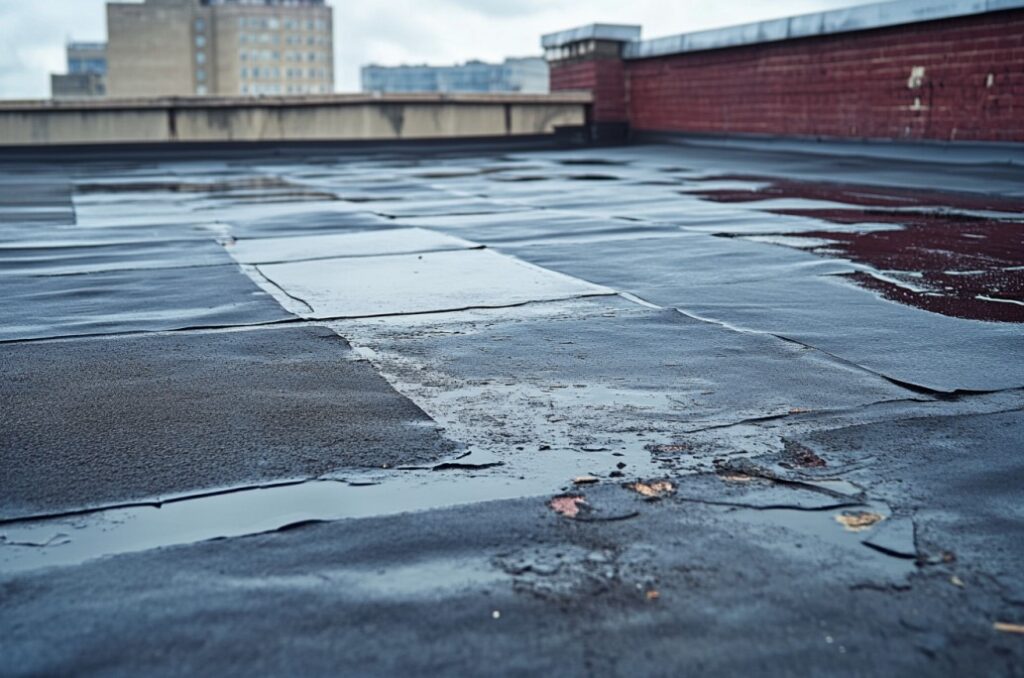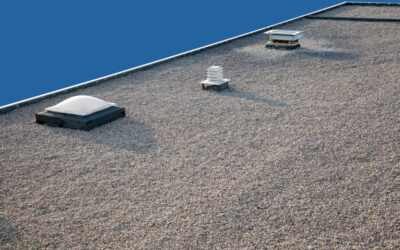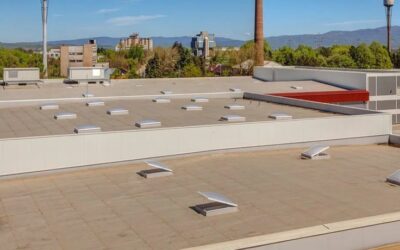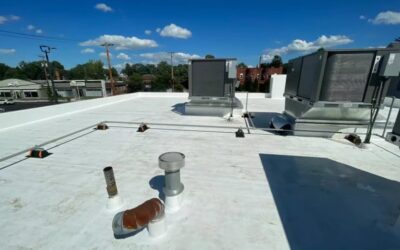A flat roof is a popular choice for many commercial and residential buildings in Philadelphia, offering practicality and cost-effectiveness. However, no roofing system lasts forever. Over time, wear and tear can lead to structural issues, leaks, and costly repairs. Recognizing the signs to replace your flat roof early can save you from unexpected expenses and serious damage to your property.
At Industrial Roofing Contractors, we specialize in flat roof installations and replacements, ensuring businesses and property owners get a durable and long-lasting roofing system. In this guide, we’ll help you determine when it’s time to consider a flat roof replacement and how to protect your investment.
How Long Should a Flat Roof Last?
Before identifying signs to replace your flat roof, it’s important to understand the expected lifespan of different flat roofing materials:
- EPDM (Rubber Roofing): 25-30 years
- TPO (Thermoplastic Polyolefin): 20-30 years
- PVC (Polyvinyl Chloride): 25-30 years
- Modified Bitumen: 15-25 years
- Built-Up Roofing (BUR): 20-30 years
Regular maintenance can extend the life of your flat roof, but once it nears the end of its expected lifespan, replacement may be necessary.
Key Signs to Replace Your Flat Roof
If you’re wondering when it’s time to consider a flat roof replacement, here are the most common warning signs:
1. Persistent Roof Leaks and Water Damage
Frequent leaks are one of the biggest red flags that your flat roof needs attention. While minor leaks can sometimes be repaired, ongoing water infiltration suggests the roofing material has deteriorated beyond repair.
Signs of water damage include:
- Water stains on ceilings and walls
- Mold or mildew growth
- Puddles of water inside the building
Philadelphia’s wet climate makes it essential to address leaks promptly before they lead to costly structural issues.
2. Pooling Water on the Roof
Flat roofs are designed with slight slopes to allow water to drain. However, if you notice standing water that remains for more than 48 hours, it could indicate drainage issues or structural sagging.
Long-term water pooling can:
- Accelerate roof membrane deterioration
- Lead to leaks and mold growth
- Add extra weight that stresses the building’s structure
If your roof consistently has standing water, it may be time for a full replacement.
3. Blistering or Bubbling on the Roof Surface
Blisters and bubbles on a flat roof occur when moisture or air gets trapped between the roof layers. Over time, these bubbles can weaken the material, leading to cracks and leaks.
This issue is particularly common in older built-up roofing (BUR) systems, and in most cases, replacing the roof is more cost-effective than repeated repairs.
4. Cracking or Splitting of Roofing Material
Extreme temperature changes in Philadelphia cause roofing materials to expand and contract. Over time, this can lead to cracks or splits in the membrane, especially in older EPDM, TPO, or PVC roofs.
Cracks allow water to penetrate, leading to interior damage. If your roof has widespread cracking, it’s a sign that a replacement is needed.

5. Flashing Damage and Separation
Flashing is the material that seals joints and edges of your flat roof, preventing water from seeping into vulnerable areas. If flashing is:
- Peeling away from the roof’s edges
- Rusting or corroding
- Cracked or missing
It can no longer protect your building from moisture. This could mean your entire roof system is failing and requires replacement.
6. Increasing Energy Bills
If your energy bills have spiked unexpectedly, your flat roof may be losing its insulating properties. Philadelphia’s cold winters and hot summers put added stress on HVAC systems when a roof can no longer regulate indoor temperatures efficiently.
A new energy-efficient roof, such as a TPO or PVC system, can significantly reduce heating and cooling costs. The U.S. Department of Energy recommends cool roofing solutions to help reduce energy consumption. (Energy.gov)
7. Mold, Mildew, or Musty Odors
A musty smell inside your building can indicate hidden water damage caused by a failing flat roof. Mold growth poses health risks and can quickly spread, leading to more expensive repairs. If mold is a recurring issue, replacing your roof may be the best long-term solution.
8. Roof Membrane Shrinking or Lifting
Some flat roofing materials, like EPDM, are prone to shrinking over time. When the membrane shrinks, it pulls away from seams and edges, leaving the roof exposed to the elements.
If your roof membrane is lifting or showing signs of shrinkage, it’s a clear indicator that a new roof may be necessary.
When Is It Time to Consider a Flat Roof Replacement?
If your flat roof has multiple issues from the list above, when is it time to consider a flat roof replacement?
Here are a few situations where replacing your roof makes more sense than repairing it:
✔ Your roof is more than 20-30 years old.
✔ You have frequent leaks despite multiple repairs.
✔ Your energy bills are increasing due to poor insulation.
✔ There is visible structural damage, like sagging or water pooling.
✔ You plan to sell or lease your building and want to improve property value.
A professional roofing inspection can help determine whether repairs are sufficient or if a full replacement is the best solution.
How a New Flat Roof Can Benefit Your Philadelphia Property
Replacing your flat roof isn’t just about fixing existing problems—it also offers long-term benefits:
🏢 Increased Property Value – A new roof boosts curb appeal and makes your property more attractive to potential buyers or tenants.
💰 Lower Maintenance Costs – A new roof reduces the need for frequent repairs, saving money in the long run.
🌡 Better Energy Efficiency – New roofing materials improve insulation and reduce energy consumption.
🌧 Stronger Weather Resistance – Modern flat roofs are designed to withstand harsh weather conditions, reducing the risk of leaks and damage.
Schedule a Free Flat Roof Inspection Today!
If you’ve noticed signs to replace your flat roof, don’t wait until the damage worsens. At Industrial Roofing Contractors, we provide expert flat roof inspections and replacement services in Philadelphia.
Not sure if you need a replacement? Our team can assess your roof’s condition and recommend the best solution for your business.
Get a free estimate now and protect your building with a durable, long-lasting roofing system!





